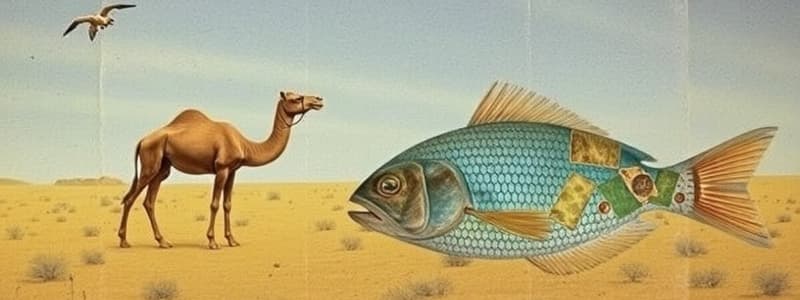Podcast
Questions and Answers
Camels can live for many days without water because they lose very little water from their bodies.
Camels can live for many days without water because they lose very little water from their bodies.
True (A)
Fish are described as having a flat shape that helps them move inside water.
Fish are described as having a flat shape that helps them move inside water.
False (B)
Adaptation is a term used to describe features that enable organisms to live in their natural habitat.
Adaptation is a term used to describe features that enable organisms to live in their natural habitat.
True (A)
The habitat of an organism does not provide necessary resources such as food or shelter.
The habitat of an organism does not provide necessary resources such as food or shelter.
Signup and view all the answers
A fish can live out of water, just like a camel can live in the sea.
A fish can live out of water, just like a camel can live in the sea.
Signup and view all the answers
Study Notes
Water and Organism Adaptations
- Oceans contain dissolved salts and support diverse organisms like camels in deserts and fishes in the sea.
- Camels are adapted to desert life with long legs to stay off hot sand, minimal water loss, and dry dung.
- They can survive several days without water due to efficient water conservation.
Fish Adaptations
- Fish display a streamlined shape, enhancing movement in water.
- They possess slippery scales that provide protection and aid in swimming.
- Fish adaptations differ based on their aquatic habitat, making them unsuitable for terrestrial living.
Distinguishing Living from Non-Living
- Habitat refers to the specific environment where organisms live, providing necessary resources like food, water, and shelter.
- Living organisms exhibit growth, respiration, and responsiveness to their environment while non-living things do not.
- Examples of non-living: chairs, tables, cars. Examples of living: plants, animals.
Characteristics of Living Organisms
- All living beings require food, respire, excrete waste, reproduce, grow, and respond to stimuli.
- Respiration provides energy from food, and all living organisms undergo this vital process.
Types of Habitats
- Habitats can be terrestrial (land) or aquatic (water), supporting various life forms.
- Biotic components include organisms, while abiotic components consist of non-living elements like air, water, and soil.
Adaptation and Survival
- Adaptation is the presence of specific features that allow organisms to live in their habitat.
- Cacti in deserts adapt by conserving water and having spines instead of leaves to reduce moisture loss.
Important Concepts
- Changes in surroundings prompt organisms to respond, indicating a characteristic of life.
- Living organisms, such as seeds, may demonstrate life processes even when not actively growing.
Common Questions and Topics
- Define habitat, adaptation, and differentiate between biotic and abiotic components.
- Explore survival strategies like speed in grasslands where cover is minimal.
- Identify non-living things that exhibit characteristics of living organisms, such as growth or movement.
Suggested Activities
- Discuss potential life forms outside Earth based on articles.
- Investigate adaptations of polar bears and penguins in their respective habitats.
- Create a habitat album documenting various environments and their inhabitants.
Studying That Suits You
Use AI to generate personalized quizzes and flashcards to suit your learning preferences.
Related Documents
Description
Explore the fascinating adaptations of various organisms, including camels and fish, to their unique environments. Learn how these adaptations allow them to thrive in their respective habitats, as well as how to distinguish between living and non-living things. This quiz will deepen your understanding of biological diversity and environmental interactions.




